Hoopoe
| Hoopoe | |
|---|---|
 | |
| | |
| Scientific classification | |
| Kingdom: | Animalia |
| Phylum: | Chordata |
| Class: | Aves |
| Order: | Bucerotiformes |
| Family: | Upupidae Leach, 1820 |
| Genus: | Upupa Linnaeus, 1758 |
| Species: | U. epops |
| Binomial name | |
| Upupa epops Linnaeus, 1758 | |
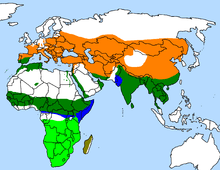 | |
| Approximate native range. nesting resident (all year) wintering | |
The hoopoe /ˈhuːpuː/ (Upupa epops) is a colourful bird found across Afro-Eurasia, notable for its distinctive "crown" of feathers. It is the only extant species in the family Upupidae. One insular species, the Saint Helena hoopoe, is extinct, and the Madagascar subspecies of the hoopoe is sometimes elevated to a full species.
Upupa and epops are respectively the Latin and Ancient Greek names for the hoopoe; both, like the English name, are onomatopoeic forms which imitate the cry of the bird.[2][3]
Taxonomy and systematics
The hoopoe was classified in the clade Coraciiformes, which also includes kingfishers, bee-eaters, and rollers.[4] A close relationship between the hoopoe and the woodhoopoes is also supported by the shared and unique nature of their stapes.[5] In the Sibley-Ahlquist taxonomy, the hoopoe is separated from the Coraciiformes as a separate order, the Upupiformes. Some authorities place the woodhoopoes in the Upupiformes as well.[6] Now the consenus is that both hoopoe and the wood hoopoes, along with the hornbills are placed in Bucerotiformes.
The fossil record of the hoopoes is very incomplete, with the earliest fossil coming from the Quaternary.[7] The fossil record of their relatives is older, with fossil woodhoopoes dating back to the Miocene and those of an extinct related family, the Messelirrisoridae, dating from the Eocene.[6]
It is the only extant member of its family, although some treatments consider some of the subspecies as separate species. Several authors have separated the Madagascan subspecies (U. e. marginata) as a separate species, and also the resident African form U. e. africana. The morphological differences between the most commonly split subspecies, U. e. marginata, and the other subspecies are minor, and only U. e. marginata has distinctly different vocalisations.[8] One accepted separate species, the Saint Helena hoopoe, U. antaios, lived on the island of St Helena but became extinct in the 16th century, presumably due to introduced species.[7]
The genus Upupa was created by Linnaeus in his Systema naturae in 1758. It then included three other species with long curved bills:[9]
- U. eremita (now Geronticus eremita), the northern bald ibis
- U. pyrrhocorax (now Pyrrhocorax pyrrhocorax), the red-billed chough
- U. paradisea
Formerly, the greater hoopoe-lark was also considered to also be a member of this genus (as Upupa alaudipes).[10]
Subspecies
.jpg)
Nine subspecies of hoopoe are recognised by Kristin (in the 2001 Handbook of the Birds of the World). They vary mostly in size and the depth of colour in the plumage. Two further subspecies have been proposed, U. e. minor in South Africa and U. e. orientalis in north western India.
| Subspecies[8] | Breeding range[8] | Distinctive features[8] |
|---|---|---|
| U. e. epops Linnaeus, 1758 |
NW Africa, Canary Islands, and from Europe through to south central Russia, north west China and south to north west India. | Nominate |
| U. e. major C.L. Brehm, 1855 |
North east Africa | Larger than nominate, longer billed, narrower tailband, greyer upperparts |
| U. e. senegalensis Swainson, 1913 |
Senegal to Ethiopia | Smaller than nominate, shorter winged |
| U. e. waibeli Reichenow, 1913 |
Cameroon through to north Kenya | As U. e. senegalensis but darker plumage and more white on wings |
| U. e. africana Bechstein, 1811 |
Central Africa to South Africa | Much more rufous than nominate |
| U. e. marginata Cabanis & Heine, 1860 |
Madagascar | Larger, much more pale than U. e. africana |
| U. e. saturata Lönnberg, 1909 |
Japan, Siberia to Tibet and south China | As nominate, greyer mantle, less pink below |
| U. e. ceylonensis Reichenbach, 1853 |
Indian Subcontinent | Smaller than nominate, more rufous overall, no white in crest |
| U. e. longirostris Jerdon, 1862 |
South east Asia | Larger than nominate, pale |
Description
_at_Hodal_I_IMG_9225.jpg)
The hoopoe is a medium-sized bird, 25–32 cm (9.8–12.6 in) long, with a 44–48 cm (17–19 in) wingspan. It weighs 46–89 g (1.6–3.1 oz). The species is highly distinctive, with a long, thin tapering bill that is black with a fawn base. The strengthened musculature of the head allows the bill to be opened when probing inside the soil. The hoopoe has broad and rounded wings capable of strong flight; these are larger in the northern migratory subspecies. The hoopoe has a characteristic undulating flight, which is like that of a giant butterfly, caused by the wings half closing at the end of each beat or short sequence of beats.[8]
The call is typically a trisyllabic oop-oop-oop, which may give rise to its English and scientific names, although two and four syllables are also common. An alternative explanation of the English and scientific names is that they are derived from the French name for the bird, huppée, which means crested. In the Himalayas, the calls can be confused with that of the Himalayan cuckoo (Cuculus saturatus), although the cuckoo typically produces four notes. Other calls include rasping croaks, when alarmed, and hisses. Females produce a wheezy note during courtship feeding by the male.[11] Both sexes, when disturbed, call a rough charrrrrr, strongly reminiscent of the warning cry of the Eurasian jay. The food begging call of the nestlings is similar to that of a common swift: tiiii.
Distribution and habitat
The hoopoe is widespread in Europe, Asia, and North Africa, Sub-Saharan Africa and Madagascar.[8] Most European and north Asian birds migrate to the tropics in winter.[12] In contrast, the African populations are sedentary all year. The species has been a vagrant in Alaska;[13] U. e. saturata was recorded there in 1975 in the Yukon Delta.[14] Hoopoes have been known to breed north of their European range,[15] and in southern England during warm, dry summers that provide plenty of grasshoppers and similar insects,[16] although as of the early 1980s northern European populations were reported to be in the decline, possibly due to changes in climate.[15]
The hoopoe has two basic requirements of its habitat: bare or lightly vegetated ground on which to forage and vertical surfaces with cavities (such as trees, cliffs or even walls, nestboxes, haystacks, and abandoned burrows[15]) in which to nest. These requirements can be provided in a wide range of ecosystems, and as a consequence the hoopoe inhabits a wide range of habitats such as heathland, wooded steppes, savannas and grasslands, as well as forest glades. The Madagascar subspecies also makes use of more dense primary forest. The modification of natural habitats by humans for various agricultural purposes has led to hoopoes becoming common in olive groves, orchards, vineyards, parkland and farmland, although they are less common and are declining in intensively farmed areas.[8] Hunting is of concern in southern Europe and Asia.[14]
Hoopoes make seasonal movements in response to rain in some regions such as in Ceylon and in the Western Ghats.[17] Birds have been seen at high altitudes during migration across the Himalayas. One was recorded at about 6,400 m (21,000 ft) by the first Mount Everest expedition.[11]
Behaviour and ecology
In what was long thought to be a defensive posture, hoopoes sunbathe by spreading out their wings and tail low against the ground and tilting their head up; they often fold their wings and preen halfway through.[18] They also enjoy taking dust and sand baths.[19]
Diet and feeding
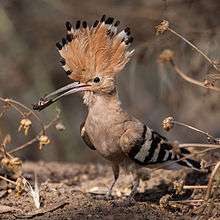
The diet of the hoopoe is mostly composed of insects, although small reptiles, frogs and plant matter such as seeds and berries are sometimes taken as well. It is a solitary forager which typically feeds on the ground. More rarely they will feed in the air, where their strong and rounded wings make them fast and manoeuvrable, in pursuit of numerous swarming insects. More commonly their foraging style is to stride over relatively open ground and periodically pause to probe the ground with the full length of their bill. Insect larvae, pupae and mole crickets are detected by the bill and either extracted or dug out with the strong feet. Hoopoes will also feed on insects on the surface, probe into piles of leaves, and even use the bill to lever large stones and flake off bark. Common diet items include crickets, locusts, beetles, earwigs, cicadas, ant lions, bugs and ants. These can range from 10 to 150 mm in length, with a preferred prey size of around 20–30 mm. Larger prey items are beaten against the ground or a preferred stone to kill them and remove indigestible body parts such as wings and legs.[8]
Breeding
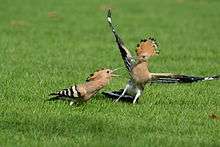
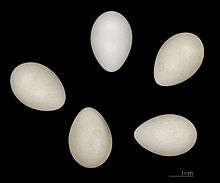
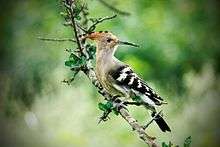
Hoopoes are monogamous, although the pair bond apparently only lasts for a single season, and territorial. The male calls frequently to advertise his ownership of the territory. Chases and fights between rival males (and sometimes females) are common and can be brutal.[8] Birds will try to stab rivals with their bills, and individuals are occasionally blinded in fights.[20] The nest is in a hole in a tree or wall, and has a narrow entrance.[19] It may be unlined, or various scraps may be collected.[15] The female alone is responsible for incubating the eggs. Clutch size varies with location: Northern Hemisphere birds lay more eggs than those in the Southern Hemisphere, and birds at higher latitudes have larger clutches than those closer to the equator. In central and northern Europe and Asia the clutch size is around 12, whereas it is around four in the tropics and seven in the subtropics. The eggs are round and milky blue when laid, but quickly discolour in the increasingly dirty nest.[8] They weigh 4.5 grams.[18] A replacement clutch is possible.[15]
Hoopoes have well-developed anti-predator defences in the nest. The uropygial gland of the incubating and brooding female is quickly modified to produce a foul-smelling liquid, and the glands of nestlings do so as well. These secretions are rubbed into the plumage. The secretion, which smells like rotting meat, is thought to help deter predators, as well as deter parasites and possibly act as an antibacterial agent.[21] The secretions stop soon before the young leave the nest.[18] From the age of six days, nestlings can also direct streams of faeces at intruders, and will hiss at them in a snake-like fashion.[8] The young also strike with their bill or with one wing.[18]
The incubation period for the species is between 15 and 18 days, during which time the male feeds the female. Incubation begins as soon as the first egg is laid, so the chicks are born asynchronously. The chicks hatch with a covering of downy feathers. By around day three to five, feather quills emerge which will become the adult feathers. The chicks are brooded by the female for between 9 and 14 days.[8] The female later joins the male in the task of bringing food.[19] The young fledge in 26 to 29 days and remain with the parents for about a week more.[15]
Relationship with humans
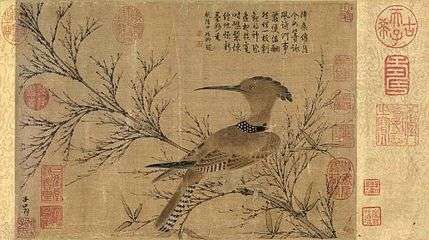
002.jpg)
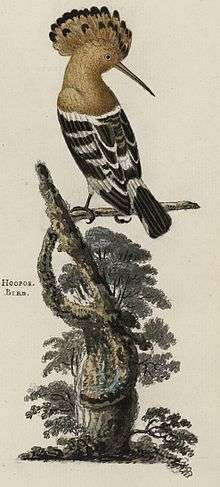
The diet of the hoopoe includes many species considered by humans to be pests, such as the pupae of the processionary moth, a damaging forest pest.[22] For this reason the species is afforded protection under the law in many countries.[8]
Hoopoes are distinctive birds and have made a cultural impact over much of their range. They were considered sacred in Ancient Egypt, and were "depicted on the walls of tombs and temples". At the Old Kingdom, the hoopoe was used in the iconography as a symbolic code to indicate the child was the heir and successor of his father.[23] They achieved a similar standing in Minoan Crete.[18]
In the Torah, Leviticus 11:13–19, hoopoes were listed among the animals that are detestable and should not be eaten. They are also listed in Deuteronomy (14:18[24]) as not kosher.
Hoopoes also appear in the Quran and is known as the "hudhud", in Surah Al-Naml 27:20–22: "And he Solomon sought among the birds and said: How is it that I see not the hoopoe, or is he among the absent? (20) I verily will punish him with hard punishment or I verily will slay him, or he verily shall bring me a plain excuse. (21) But he [the hoopoe] was not long in coming, and he said: I have found out (a thing) that thou apprehendest not, and I come unto thee from Sheba with sure tidings." Islamic literature also states that a hoopoe saved Moses and the children of Israel from being crushed by the giant Og[25] after crossing the Red Sea.[26]
Hoopoes were seen as a symbol of virtue in Persia. A hoopoe was a leader of the birds in the Persian book of poems The Conference of the Birds ("Mantiq al-Tayr" by Attar) and when the birds seek a king, the hoopoe points out that the Simurgh was the king of the birds.[27]
Hoopoes were thought of as thieves across much of Europe, and harbingers of war in Scandinavia.[28] In Estonian tradition, hoopoes are strongly connected with death and the underworld; their song is believed to foreshadow death for many people or cattle.[29]
The hoopoe is the king of the birds in the Ancient Greek comedy The Birds by Aristophanes. In Ovid's Metamorphoses, book 6, King Tereus of Thrace rapes Philomela, his wife Procne's sister, and cuts out her tongue. In revenge, Procne kills their son Itys and serves him as a stew to his father. When Tereus sees the boy's head, which is served on a platter, he grabs a sword but just as he attempts to kill the sisters, they are turned into birds—Procne into a swallow and Philomela into a nightingale. Tereus himself is turned into an epops (6.674), translated as lapwing by Dryden[30] and lappewincke (lappewinge) by John Gower in his Confessio Amantis,[31] or hoopoe in A.S. Kline's translation.[32] The bird's crest indicates his royal status, and his long, sharp beak is a symbol of his violent nature. English translators and poets probably had the northern lapwing in mind, considering its crest.
The hoopoe was chosen as the national bird of Israel in May 2008 in conjunction with the country's 60th anniversary, following a national survey of 155,000 citizens, outpolling the white-spectacled bulbul.[33][34] The hoopoe appears on the Logo of the University of Johannesburg and is the official mascot of the University's sports. The municipalities of Armstedt and Brechten, Germany, have a hoopoe in its coat of arms.
In Morocco, hoopoes are traded live and as medicinal products in the markets, primarily in herbalist shops. This trade is unregulated and a potential threat to local populations [35]
Three CGI enhanced hoopoes, together with other birds collectively named "the tittifers", are often shown whistling a song in the BBC children's television series In the Night Garden....
References
- ↑ BirdLife International (2012). "Upupa epops". IUCN Red List of Threatened Species. Version 2013.2. International Union for Conservation of Nature. Retrieved 26 November 2013.
- ↑ Jobling, James A (2010). The Helm Dictionary of Scientific Bird Names. London: Christopher Helm. pp. 147, 396. ISBN 978-1-4081-2501-4.
- ↑ "Hoopoe". Oxford English Dictionary (3rd ed.). Oxford University Press. September 2005. (Subscription or UK public library membership required.)
- ↑ Hackett, Shannon J.; et al. (2008). "A Phylogenomic Study of Birds Reveals Their Evolutionary History". Science. 320 (1763): 1763–1768. doi:10.1126/science.1157704. PMID 18583609.
- ↑ Feduccia, Alan (1975). "The Bony Stapes in the Upupidae and Phoeniculidae: Evidence for Common Ancestry" (PDF). The Wilson Bulletin. 87 (3): 416–417.
- 1 2 Mayr, Gerald (2000). "Tiny Hoopoe-Like Birds from the Middle Eocene of Messel (Germany)". Auk. 117 (4): 964–970. doi:10.1642/0004-8038(2000)117[0964:THLBFT]2.0.CO;2.
- 1 2 Olson, Storrs (1975). Paleornithology of St Helena Island, south Atlantic Ocean (PDF). Smithsonian Contributions to Paleobiology. 23.
- 1 2 3 4 5 6 7 8 9 10 11 12 13 Kristin, A (2001). "Family Upupidae (Hoopoes)". In Josep, del Hoyo; Andrew, Elliott; Sargatal, Jordi. Handbook of the Birds of the World. Volume 6, Mousebirds to Hornbills. Barcelona: Lynx Edicions. pp. 396–411. ISBN 84-87334-30-X.
- ↑ (Latin) Linnaeus, C (1758). Systema naturae per regna tria naturae, secundum classes, ordines, genera, species, cum characteribus, differentiis, synonymis, locis. Tomus I. Editio decima, reformata. Holmiae. (Laurentii Salvii). pp. 117–118.
- ↑ "Alaemon alaudipes - Avibase". avibase.bsc-eoc.org. Retrieved 2016-11-17.
- 1 2 Ali, S.; Ripley, S. D. (1983). Handbook of the Birds of India and Pakistan. Volume 4 (2nd ed.). Oxford University Press, New Delhi. pp. 124–129.
- ↑ Reichlin, Thomas; Michael Schaub; Myles H. M. Menz; Murielle Mermod; Patricia Portner; Raphaël Arlettaz; Lukas Jenni (2008). "Migration patterns of Hoopoe Upupa epops and Wryneck Jynx torquilla: an analysis of European ring recoveries" (PDF). Journal of Ornithology. 150 (2): 393. doi:10.1007/s10336-008-0361-3.
- ↑ Dau, Christian; Paniyak, Jack (1977). "Hoopoe, A First Record for North America" (PDF). Auk. 94 (3): 601.
- 1 2 Heindel, Matthew T. (2006). Jonathan Alderfer, ed. Complete Birds of North America. National Geographic Society. p. 360. ISBN 0-7922-4175-4.
- 1 2 3 4 5 6 Pforr, Manfred; Alfred Limbrunner (1982). The Breeding Birds of Europe 2: A Photographic Handbook. London: Croom and Helm. p. 82. ISBN 0-7099-2020-2.
- ↑ Soper, Tony (1982). Birdwatch. Exeter, England: Webb & Bower. p. 141. ISBN 0-906671-55-8.
- ↑ Champion-Jones, RN (1937). "The Ceylon Hoopoe (Upupa epops ceylonensis Reichb.)". J. Bombay Nat. Hist. Soc. 39 (2): 418.
- 1 2 3 4 5 Fry, Hilary C. (2003). Christopher Perrins, ed. Firefly Encyclopedia of Birds. Firefly Books. p. 382. ISBN 1-55297-777-3.
- 1 2 3 Harrison, C.J.O.; Christopher Perrins (1979). Birds: Their Ways, Their World. The Reader's Digest Association. pp. 303–304. ISBN 0-89577-065-2.
- ↑ Martín-Vivaldi, Manuel; Palomino, José J.; Soler, Manuel (2004). "Strophe Length in Spontaneous Songs Predicts Male Response to Playback in the Hoopoe Upupa epops". Ethology. 110 (5): 351–362. doi:10.1111/j.1439-0310.2004.00971.x.
- ↑ Martín-Platero, Antonio M.; et al. (2006). "Characterization of Antimicrobial Substances Produced by Enterococcus faecalis MRR 10-3, Isolated from the Uropygial Gland of the Hoopoe (Upupa epops)". Applied and Environmental Microbiology. 72 (6): 4245–4249. doi:10.1128/AEM.02940-05. PMC 1489579
 . PMID 16751538.
. PMID 16751538. - ↑ Battisti, A; Bernardi, M.; Ghiraldo, C. (2000). "Predation by the hoopoe (Upupa epops) on pupae of Thaumetopoea pityocampa and the likely influence on other natural enemies". Biocontrol. 45 (3): 311–323. doi:10.1023/A:1009992321465.
- ↑ Marshall, Amandine (2015). "The child and the hoopoe in ancient Egypt". Kmt. 72 (26.1): 59–63.
- ↑ Deuteronomy Chapter 14:18. mechon-mamre.org
- ↑ M. Th Houtsma (1987). E.J. Brill's First Encyclopaedia of Islam, 1913-1936. Brill Academic Publishers. p. 990. ISBN 9789004082656.
- ↑ The Baz-Nama-Yi Nasiri: A Persian Treatise on Falconry. Translated by Phillott, D.C. London: Bernard Quaritch. 1908. p. 151.
- ↑ Smith, Margaret (1932). The Persian Mystics 'Attar'. New York: E.P.Dutton and Company. p. 27.
- ↑ Dupree, N (1974). "An Interpretation of the Role of the Hoopoe in Afghan Folklore and Magic". Folklore. 85 (3): 173–93. doi:10.1080/0015587X.1974.9716553. JSTOR 1260073.
- ↑ Mall Hiiemäe, Forty birds in Estonian folklore IV. translate.google.com
- ↑ Garth, Samuel; Dryden, John; et al. "'Metamorphoses' by Ovid".
- ↑ Book 5, lines 6041 and 6046. Gower, John. "Confessio Amantis". Project Gutenberg. Retrieved 2009-02-17.
- ↑ Kline, A.S. (2000). "The Metamorphoses: They are transformed into birds". Archived from the original on 2007-07-11. Retrieved 2009-02-17.
- ↑ Reuters (May 29, 2008). "Day in pictures". San Francisco Chronicle.
- ↑ "Hoopoe Israel's new national bird". ynet.
- ↑ Daniel Bergin, Mohamed Amezian
External links
| Wikimedia Commons has media related to Upupa epops. |
- Hoopoe- Species text in The Atlas of Southern African Birds.
- Ageing and sexing (PDF; 5.3 MB) by Javier Blasco-Zumeta & Gerd-Michael Heinze
- Hoopoe videos, photos & sounds on the Internet Bird Collection
-
 "Hoopœ". Collier's New Encyclopedia. 1921.
"Hoopœ". Collier's New Encyclopedia. 1921. -
 "Hoopoe". Encyclopedia Americana. 1920.
"Hoopoe". Encyclopedia Americana. 1920.
